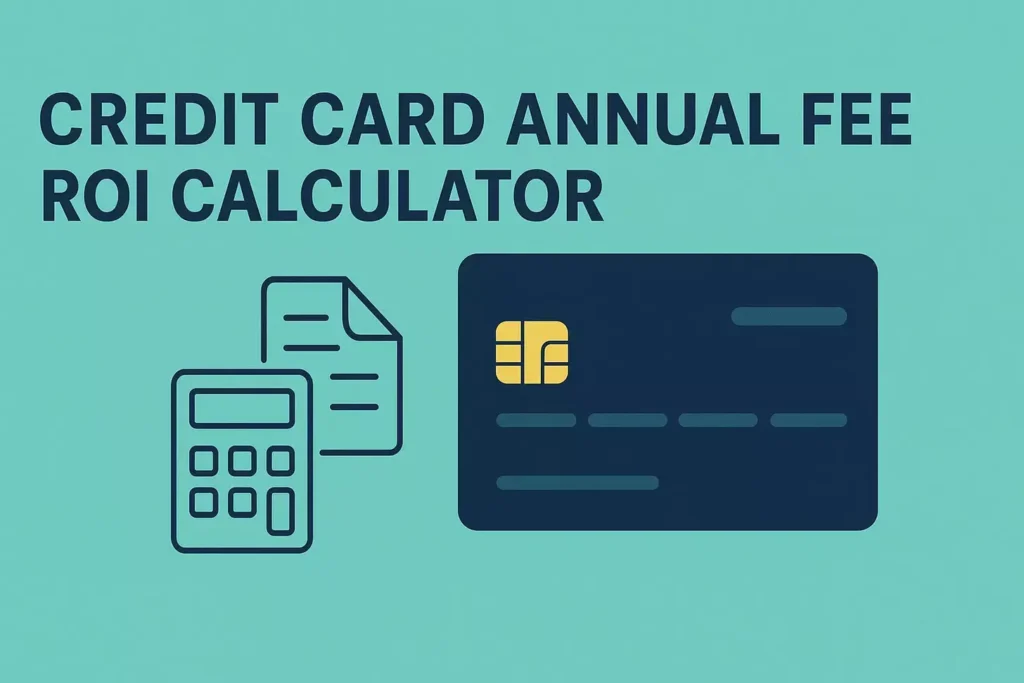Affiliate Disclosure: Travel with Plastic may earn a commission or referral bonus from some links on this site. These affiliate links help support our work and may influence the placement or promotion of certain products or services. However, our content is independently crafted to reflect honest opinions. Not all offers or products are included. There is no additional cost to users when they utilize our affiliate links.
Surprising fact: some issuer changes push sticker prices higher — the Chase Sapphire Reserve moved toward a $795 level after previously listing $550.
We’ve established a practical framework to help you determine if an expensive account is worthwhile this year. Our approach uses real spend, realistic redemptions, and the perks you will actually use.
We translate benefits into dollars, compare them against the cost, and factor in rates on savings or debt so you see true value, not marketing hype.
We preview the inputs you enter in the tool — yearly charge, expected credits, rewards rates, and monthly spend patterns — and show a worked example. We also flag program quirks like enrollment steps or terms apply that can reduce real value.
Our goal is clear: help you quantify value, manage overall charges across your portfolio, and use the money you already spend to unlock real benefits.
Key Takeaways
- Use real spending and realistic redemptions to measure net value.
- Convert perks and statement credits into dollars before you renew.
- Watch program rules — enrollment and terms apply matter.
- Compare benefits to competing rates on savings or debt.
- Manage multiple accounts to avoid overlapping charges and lost value.
How to use a credit card annual fee ROI framework today
Begin with a simple inventory: list the fee, your monthly purchases by category, and the benefits you expect to use. Keep this practical — only include statement credits and perks you will realistically claim over the next 12 months.
Next, input each item into our calculator once and then tweak assumptions. Change redemption value, or how many months a monthly credit is captured, to see how sensitive your net value is to behavior.
Remember to quantify perks beyond points. Assign a cash value to lounge visits, checked bags, or elite status to capture true savings. Add opportunity cost — a strong no-fee alternative or a better category bonus elsewhere — so you avoid overstating benefits.

- Build a habit: review the framework before you use benefits to avoid accidental overlap.
- Save inputs and rerun at renewal to decide whether to keep or downgrade.
| Input | Example value | Notes |
|---|---|---|
| Annual fee | $250 | Actual posted cost for the year |
| Monthly statement credits | $15 x 8 months | Estimate months you will capture |
| Purchases by category | Groceries $6,000; Travel $2,000 | Used to estimate rewards earned |
| Perks value | $200 | Lounge visits, baggage fee waivers, etc. |
Build your calculator: the inputs, math, and outputs that matter
We build a simple model that converts your routine spend and perks into a clear net result. This lets us test whether the numbers line up for your situation over a year.
Key inputs
Enter the basics: your fee, projected points from category bonuses and base earnings, and a realistic redemption rate. Add monthly statement credits and note how many months you will actually capture them.
- Include one-time credits and whether you’ve enrolled for them.
- Quantify perks like lounge access or baggage waivers by actual money saved and discount overlapping benefits.
- Model breakage: reduce expected credits if you often miss months.

The math
Net value = (rewards + benefits + credits) − (fees + breakage + opportunity cost). Use this to convert points spending into dollars at a realistic rates figure.
Outputs you’ll see
| Output | What it shows | Example |
|---|---|---|
| Break-even spend | Spend needed to cover the fee | $18,000 |
| Payback period | Months until net value > 0 | 8 months |
| Per-year net value | Estimated money saved or lost in the year | $240 |
Tip: AskSebby’s tool shows how monthly Uber Cash and dining credits alter the math for the American Express Gold Card in a real example.
Step-by-step: evaluate a premium card’s value before you pay the fee
Before you renew, run a clear checklist that converts perks and credits into real dollars. We walk through practical checks to confirm which benefits you will actually capture over the next year.
Verify statement credits you’ll actually use
Check each statement credit’s rules: does it require enrollment, have monthly caps, or rely on merchant coding? A travel credit that auto-applies to coded travel purchases is easier to use than a portal-only credit.
Quantify ongoing perks and avoid overlap
List lounges, free checked bags, elite membership perks, and purchase protections. Assign a dollar value only if you would otherwise pay for them.
Audit overlap across accounts so you don’t double-count the same lounge or Global Entry credit.
Factor travel and shopping protections
Read terms apply clauses for trip delay, baggage delay, and return protection. Strong protections can offset part of the fee when disruptions occur.
Assess your whole portfolio
Compare total annual fee obligations and stacked benefits. Portal-only credits can lower value if you must be booked directly to keep elite perks or free breakfast.
| Check | Why it matters | Action |
|---|---|---|
| Statement credits | May require enrollment or coding | Estimate months you’ll redeem |
| Perks value | Only real if you’d pay otherwise | Assign conservative dollars |
| Booking rules | Portal vs booked directly affects perks | Price-check portal vs direct |
| Overlap | Duplicate memberships inflate totals | Remove redundant products appear in portfolio |
Worked example: Is the American Express Gold Card worth it this year?
Let’s run a concrete example to see whether the Amex Gold earns its keep this year. We model the product with the published $325 annual fee and common benefits: monthly uber cash and monthly dining statement credits, plus points for groceries and restaurants.
Credits in practice: monthly uber cash applies after you add the card to one Uber account and works for Uber Eats and U.S. rides. Monthly dining statement credits often work with partners like Grubhub but frequently require activation — enrollment required and terms apply.
We assume a user captures Uber Eats three months out of four and redeems dining credits most months. For rewards, estimate annual dining and grocery spend, apply gold multipliers, and convert points at a conservative redemption rate to dollars.
Break-even and sensitivity
Run the math: total benefits (credits + points value) minus the $325 fee and any breakage. Then compute months to break even.
| Input | Example | Notes |
|---|---|---|
| Annual charge | $325 | See rates fees |
| Months capture (Uber) | 9 of 12 | Assumes 75% usage of monthly Uber cash |
| Months capture (dining) | 10 of 12 | Reflects partner availability and enrollment required |
| Points value | $180 | Based on dining/grocery points spending and conservative redemption |
| Net value | $60 | (Credits + points) − $325; positive means break-even within year |
Tip: Run a sensitivity test: drop captured months or lower point redemption. If the net value remains positive, the gold product has margin for user error.
Summary: if your modeled utilization of monthly uber cash, monthly dining statement credits, and grocery/dining points exceeds the annual charge within several months, keeping the gold product can make sense. If you won’t complete enrollment steps or you rarely use partner services like Uber Eats, reduce assumed months and re-run the math.
Credit Card Annual Fee ROI Calculator: When Premium Cards Pay Off
A smart booking choice can protect elite perks and preserve the true value of your membership. Some $300 travel credits auto-apply to travel purchases (for example, Chase Sapphire Reserve) while others need portal bookings (Capital One Venture X via Capital One Travel). That difference can change the price and whether elite hotel or airline benefits still apply.
Booking portal vs booked directly
Before you hit confirm, compare portal pricing to direct rates. Sometimes booking directly keeps elite upgrades, free breakfast, or promos that a portal booking won’t.
| Booking path | Typical impact | When to prefer |
|---|---|---|
| Portal booking | Uses credits but may void elite perks | When portal price is significantly lower |
| Booked directly | Preserves membership status and promos | When upgrades or benefits matter more than small savings |
| Hybrid (call property) | Can combine portal benefits and elite recognition | When negotiation or confirmation is possible |
Avoiding breakage: set-and-forget tactics
Missed statement credits and monthly perks waste real money. We recommend simple automations to reduce loss.
- Plan big trips if a portal-only credit requires large bookings to use fully.
- Link and default your preferred method so uber cash and monthly dining apply automatically.
- Track redemptions with a tiny spreadsheet or calendar reminders before month-end.
- Consolidate membership use—pick one primary card for lounge access to avoid paying duplicate fees.
Tip: Re-run the calculator after automating redemptions. Fewer missed credits often moves net value into positive territory.
Don’t ignore the debt side: your interest rate may beat any card “return”
We often overlook that reducing a high-rate balance delivers a guaranteed, tax-free return equal to the interest saved.
Paying 18–19% APR on revolving balances is a real, measurable loss. Every extra payment chips away at that interest and gives you the same percent back as a direct, risk-free return.
Run the numbers before chasing new offers. Use a simple tool to compare directing a lump sum to debt versus meeting a welcome spend and fees. You’ll see how many months of payoff you shorten and how much money you avoid sending to interest.
- If you carry balances at 18–19% per year, extra principal often beats speculative rewards.
- A conservative example: redirecting a few hundred dollars to a high-rate balance can save more money than a typical signup bonus after considering fees and spending needs.
- Sequence actions: clear the highest rates first, then return to optimizing rewards once utilization and costs improve.
- Reassess annually — neutralizing interest can increase overall value and financial stability for the year ahead.
Tip: Treat debt reduction as an effective, tax-free investment. It raises your net worth immediately by lowering future interest outflows.
| Scenario | Action | Impact |
|---|---|---|
| Balance at 18% APR | Apply $300 lump sum | Shortens payoff by several months; saves interest |
| New welcome offer | Meet spend + pay fee | Value reduced by fees and breakage risk |
| Sequence plan | Pay high rates first | Then consider switching to a high-value ongoing card |
Optimize before you cancel: retention offers, downgrades, and timing
A well-timed ask can turn an upcoming renewal into a meaningful net gain. Before you cancel, contact the issuer and request an offer. Many issuers will propose bonus points, a statement incentive, or a reduced fee to keep the account active.
With American Express, cardholders on the Platinum Card® have reported 10,000–20,000 Membership Rewards for a modest spend target. That type of offer can cut the net cost by hundreds based on point valuations.
Practical steps to decide
- Ask for an offer near renewal, not after the charge posts.
- Inventory which membership perks you actually use; overlapping lounge or elite perks can justify a downgrade.
- Consider a product change to preserve account age and score while eliminating the higher fee.
- Confirm any enrollment required steps for credits before switching products.
Tip: Capture usable statement credits first, then accept or decline the offer based on net value and long‑term strategy.
Conclusion
Final decisions are easiest when numbers guide the choice, not headlines.
Use our simple model to quantify benefits, statement credits, and points spending against the annual fee. Focus on net value per year and realistic use of monthly perks like uber cash and monthly dining.
Manage money first by reducing high rates on outstanding balances, then layer in the right offers and membership protections. Strong travel protections — such as baggage delay coverage — can replace out-of-pocket costs during disruptions.
If your current setup no longer fits, request a retention offer or evaluate a new card that matches your spending pattern. Keep a lean portfolio so fees don’t stack and so you retain the protections you actually use.
Revisit this framework annually. Small changes in rates, terms, or travel plans often flip the math. The right card, used correctly, returns real money — and when it doesn’t, we make the change with confidence.

